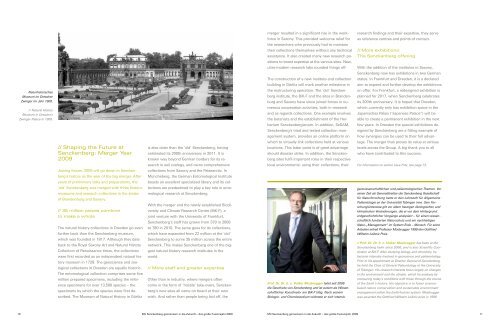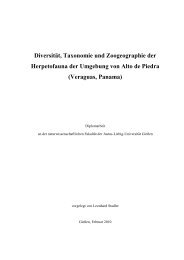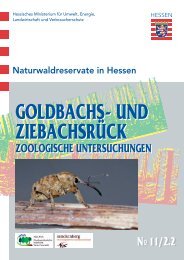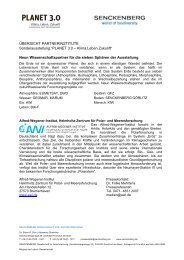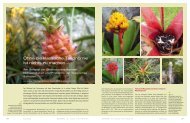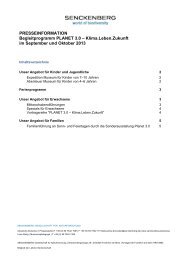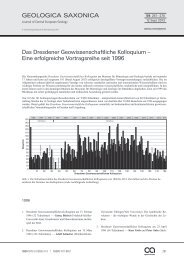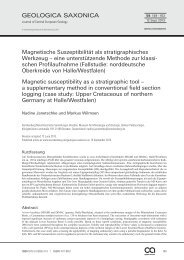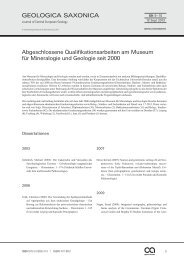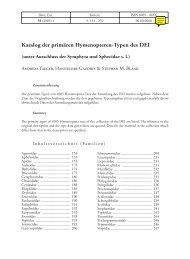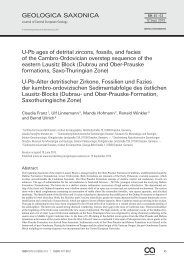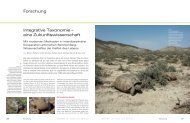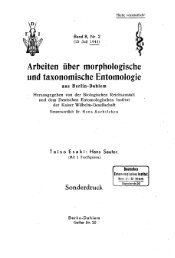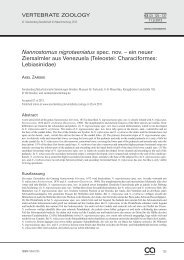Jahresbericht 2009-2010 - Senckenberg
Jahresbericht 2009-2010 - Senckenberg
Jahresbericht 2009-2010 - Senckenberg
Erfolgreiche ePaper selbst erstellen
Machen Sie aus Ihren PDF Publikationen ein blätterbares Flipbook mit unserer einzigartigen Google optimierten e-Paper Software.
merger resulted in a significant rise in the work-<br />
research findings and their expertise, they serve<br />
force in Saxony. This provided welcome relief for<br />
as reference centres and points of contact.<br />
the researchers who previously had to maintain<br />
their collections themselves without any technical<br />
// More exhibitions:<br />
assistance. It also created many new research po-<br />
The <strong>Senckenberg</strong> offering<br />
sitions to boost expertise at the various sites. New,<br />
ultra-modern research labs rounded things off.<br />
With the addition of the institutes in Saxony,<br />
<strong>Senckenberg</strong> now has exhibitions in two German<br />
The construction of a new institute and collection<br />
states. In Frankfurt and Dresden, it is a declared<br />
building in Görlitz will mark another milestone in<br />
aim to expand and further develop the exhibitions<br />
Naturhistorisches<br />
Museum im Dresdner<br />
the restructuring operation. The ‘old’ <strong>Senckenberg</strong><br />
institute, the BiK-F and the sites in Branden-<br />
on offer. For Frankfurt, a redesigned exhibition is<br />
planned for 2017, when <strong>Senckenberg</strong> celebrates<br />
Zwinger im Jahr 1900.<br />
burg and Saxony have since joined forces in nu-<br />
its 200th anniversary. It is hoped that Dresden,<br />
// Natural History<br />
Museum in Dresden’s<br />
Zwinger Palace in 1900.<br />
merous cooperation activities, both in research<br />
and as regards collections. One example involves<br />
the botanists and the establishment of the Her-<br />
which currently only has exhibition space in the<br />
Japanisches Palais (“Japanese Palace”) will be<br />
able to create a permanent exhibition in the next<br />
barium <strong>Senckenberg</strong>ianum. In addition, SeSAM,<br />
few years. In Dresden the special exhibitions de-<br />
<strong>Senckenberg</strong>’s tried and tested collection man-<br />
signed by <strong>Senckenberg</strong> are a fitting example of<br />
agement system, provides an online platform on<br />
how synergies can be used to their full advan-<br />
// Shaping the Future at<br />
<strong>Senckenberg</strong>: Merger Year<br />
<strong>2009</strong><br />
is also older than the ‘old’ <strong>Senckenberg</strong>, having<br />
celebrated its 200th anniversary in 2011. It is<br />
known way beyond German borders for its re-<br />
which to virtually link collections held at various<br />
locations. This latter point is of great advantage<br />
should disaster strike. In addition, the <strong>Senckenberg</strong><br />
sites fulfil important roles in their respective<br />
tage. The merger thus proves its value at various<br />
levels across the Group. A big thank you to all<br />
who have contributed to this success.<br />
search in soil zoology, and owns comprehensive<br />
local environments: using their collections, their<br />
For information on author Uwe Fritz, see page 73.<br />
Joining forces: <strong>2009</strong> will go down in Sencken-<br />
collections from Saxony and the Palaearctic. In<br />
berg’s history as the year of the big merger. After<br />
Müncheberg, the German Entomological Institute<br />
years of preliminary talks and preparations, the<br />
boasts an excellent specialised library and its col-<br />
‘old’ <strong>Senckenberg</strong> was merged with three historic<br />
museums and research collections in the states<br />
of Brandenburg and Saxony.<br />
// 35 million pieces combine<br />
to make a whole<br />
The natural history collections in Dresden go even<br />
further back than the <strong>Senckenberg</strong> museum,<br />
lections are predestined to play a key role in entomological<br />
research at <strong>Senckenberg</strong>.<br />
With the merger and the newly established Biodiversity<br />
and Climate Research Centre (BiK-F), a<br />
joint venture with the University of Frankfurt,<br />
<strong>Senckenberg</strong>’s staff has grown from 370 in 2008<br />
to 780 in <strong>2010</strong>. The same goes for its collections,<br />
which have expanded from 22 million at the ‘old’<br />
geo wissenschaftlichen und paläontologischen Themen. Vor<br />
seiner Zeit als Generaldirektor der <strong>Senckenberg</strong> Gesellschaft<br />
für Naturforschung hatte er den Lehrstuhl für Allgemeine<br />
Paläontologie an der Universität Tübingen inne. Sein Forschungsinteresse<br />
gilt vor allem heutigen ökologischen und<br />
klimatischen Veränderungen, die er vor dem Hintergrund<br />
erdgeschichtlicher Vorgänge analysiert – für einen wissenschaftlich<br />
fundierten Naturschutz und ein nachhaltiges<br />
Natur-„Management“ im System Erde – Mensch. Für seine<br />
Arbeiten erhielt Professor Mosbrugger 1998 den Gottfried<br />
Wilhelm Leibniz-Preis.<br />
which was founded in 1817. Although they date<br />
back to the Royal Saxony Art and Natural History<br />
Collection of Renaissance times, the collections<br />
were first recorded as an independent natural history<br />
museum in 1728. The geoscience and zoological<br />
collections in Dresden are equally historic.<br />
The entomological collection comprises some five<br />
<strong>Senckenberg</strong> to some 35 million across the entire<br />
network. This makes <strong>Senckenberg</strong> one of the biggest<br />
natural history research institutes in the<br />
world.<br />
// More staff and greater expertise<br />
// Prof. Dr. Dr. h. c. Volker Mosbrugger has been at the<br />
<strong>Senckenberg</strong> helm since 2006, and is also Scientific Coordinator<br />
at BiK-F. After studying biology and chemistry, he<br />
became intensely involved in geoscience and palaeontology.<br />
Prior to his appointment as Director General of <strong>Senckenberg</strong>,<br />
he held the Chair of General Paleontology at the University<br />
of Tübingen. His research interests focus largely on changes<br />
in the environment and the climate, which he analyses by<br />
million prepared specimens, including the reference<br />
specimens for over 13,500 species – the<br />
specimens by which the species were first described.<br />
The Museum of Natural History in Görlitz<br />
Other than in industry, where mergers often<br />
come in the form of ‘hostile’ take-overs, <strong>Senckenberg</strong>’s<br />
new sites all came on board at their own<br />
wish. And rather than people being laid off, the<br />
Prof. Dr. Dr. h. c. Volker Mosbrugger leitet seit 2006<br />
die Geschicke von <strong>Senckenberg</strong> und ist zudem als Wissenschaftlicher<br />
Koordinator am BiK-F tätig. Nach seinem<br />
Bio logie- und Chemiestudium widmete er sich intensiv<br />
comparing today’s conditions with those through the course<br />
of the Earth’s history. His objective is to foster sciencebased<br />
nature conservation and sustainable environment<br />
management within the Earth/human system. Mosbrugger<br />
was awarded the Gottfried Wilhelm Leibniz prize in 1998.<br />
10 Mit <strong>Senckenberg</strong> gemeinsam in die Zukunft – das große Fusionsjahr <strong>2009</strong><br />
Mit <strong>Senckenberg</strong> gemeinsam in die Zukunft – das große Fusionsjahr <strong>2009</strong> 11


